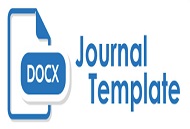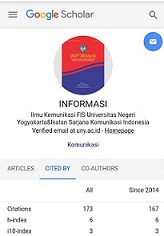Pemetaan Gerakan Literasi Digital di Lingkup Universitas Negeri Yogyakarta
Dyna Herlina Suwarto, Universitas Negeri Yogyakarta, Indonesia
Abstract
ABSTRAK
Konten digital pada masa ini dapat diakses dengan mudah oleh beragam kalangan. Walau begitu, masih terdapat kesenjangan dalam penggunaan internet di kalangan masyarakat Indonesia. Hal itulah yang melatarbelakangi upaya berbagai pihak untuk meningkatkan kemampuan literasi digital masyarat Indonesia. Penelitian ini mencoba untuk memetakan gerakan literasi digital yang dilakukan di lingkup Universitas Negeri Yogyakarta (UNY). Metode yang digunakan adalah deskriptif kualitatif dengan metode pengambilan data wawancara mendalam terhadap pelaku kegiatan dengan menggunakan instrumen dari Jaringan Pegiat Literasi Digital. Sejumlah lima belas kegiatan literasi digital di lingkup UNY dianalisis dan digolongkan kedalam enam pendekatan literasi media berdasarkan hasil indeks latar belakang, metode, dan praktek dari kegiatan tersebut. Dari hasil analisis, sejumlah satu kegiatan literasi tergolong dalam pendekatan Protectionism, empat kegiatan literasi tergolong dalam pendekatan Active Audience, tujuh kegiatan literasi tergolong dalam pendekatan Critical Analytical, satu kegiatan literasi tergolong dalam pendekatan Creative Media, dan dua kegiatan literasi lainnya tergolong dalam pendekatan gabungan. Satu kegiatan mengadopsi gabungan pendekatan Media Creative dan pendekatan Media Fun, sedangkan kegiatan lainnya mengadopsi gabungan antara pendekatan Critical Analytical dan Media Fun. Kesimpulan yang didapatkan yaitu pihak-pihak penyelenggara yang berkecimpung dalam dunia Ilmu Komunikasi cenderung lebih mengenal beragam variasi pendekatan. Sehingga, dalam program literasi digital yang diusungnya, pendekatan yang dibawa disesuaikan dengan target yang akan dituju.
ABSTRACT
In the age of digital world, anybody can easily access the digital content. However, there is still a gap within the internet usage amongst Indonesian people. This is exactly the reason behind the efforts of various communities in order to improve digital capabilities of Indonesian society.This research tried to map various digital literacy movement in Yogyakarta State University (YSU). The method used is descriptive-qualitative with in-depth interviews by using instruments from Jaringan Pegiat Literasi Digital. With a total of fifteen digital literacy activities in YSU are analyzed and classified into six media literacy approaches based on the index results of the background, methods, and practices of those activities.According to the analysis, a number of digital literacy activities belong to the Protectionism Approach, four belong to the Active Audience Approach, seven are categorized in the Critical Analytical Approach, one belong to the Creative Media Approach, and the rest of other two digital literacy activities are belong to mixed approaches. One digital literacy activity adopted an mixed approaches between Creative Media Approach and Media Fun Approach, while the other one adopted a combination of Critical Analytical Approach and Media Fun Approach.The results of this research showed that people who learned Communication Studies are tend to be more familiar with variety of approaches compared with those who are not major in Communication Studies. Thus, in their digital literacy movement programs, they knew which approaches that suitable for the target group they addressed to.
Keywords
Full Text:
PDFReferences
Amedie, Jacob. (2015). Pop Culture Intersections: The Impact of Social Media in Society. California: Santa Clara University.
Arke, Edward. (2005). Media Literacy And Critical Thinking: Is There A Connection?. Disertasi. Interdisciplinary Doctoral Program for Educational Leaders School of Education Duquesne University. Austin, Erica W., Kallman,
Davi I.,Kistler, Michelle. (2017). Media Literacy Approaches for ImprovingYouth and Family Health. Dalam Belinha S. De Abreu (Ed.), Paul Mihailidis (Ed.), Alice Y.L. Lee (Ed.), Jad Melki (Ed.), Julian McDougall (Ed.), International Handbook of Media Literacy Education. New York: Routledge.
Bazalgette, Cary. (2009). Whose Interest Should Media Literacy Serve?. Dalam Patrick Vernierss (Ed.), Media Literacy in Europe: Controversies, Challanges and Perspectives. Bruxelles: Euro Meduc.
Biocca, Frank. (1988). Opposing Conceptions of the Audience: The Active and Passive Hemispheres of Mass Communication Theory. Annals of the International Communication Association. Vol. 11. No. 1, pp. 51 – 80.
Buckingham, David. (2007). Digital Media Literacies: Rethinking Media Education in The Age Of The Internet. Research in Comparative and International Education. Vol. 2, No. 1.
Buckingham, David. (2009). The Future of Media Literacy in the Digital Age: Some Challenges for Policy and Practice. Dalam Patrick Vernierss (Ed.), Media Literacy in Europe: Controversies, Challanges and Perspectives. Bruxelles: Euro Meduc.
Department of eLearning (2015). Digital Literacy: 21st Century Competences for Our Age. https://education.gov.mt/en/elearning/Documents/Green%20Paper%20Digital%20Literacy%20v6.pdf diakses pada tanggal 18 Agustus 2017 pukul 10.02 WIB
Hague, Cassie., Payton, Sarah. (2010). Digital Literacy Across the Curriculum. Inggris: Futurelab.
Kellner, Douglas., Share, Jeff. (2007). Critical Media Literacy, Democracy, and Reconstruction of Education. New York: Peter Lang Publishing, Inc.
Kuntjojo. (2009). Metodologi Penelitian. Kediri: Universitas Nusantara PGRI Kediri.
Lahiji, Artin. (2008). Critical Media Education: Youth Media Production as a Space for Creativity for Lifelong Learning. Tesis. Departement of Interdisciplinary Studies University of Saskatchewan Saskatoon.
Lankshear, Colin., Knobel, Michele. (2008). Digital Literacies: Concepts, Policies, and Practices. New York: Peter Lang Publishing, Inc.
Lee, Alice Y.L. (2010). Media Education: Definitions, Approaches and Development around the Globe. New Horizons in Education. Vol. 58. No. 3.
Littlejohn, Stephen W., Foss, Karen A. (2008). Theories of Human Communication 9th Edition. Amerika Serikat: Thomson Wadsworth.
Mihailidis, Paul. (2009). Beyond Cynicism: Media Education and Civic Learning Outcomes in the University. Massachusetts Institute of Technology. Vol. 1. No. 3.
Redmon, Theresa. (2012). The Pedagogy of Critical Enjoyment: Teaching and Reaching the Hearts and Minds of Adolescent Learners Through Media Literacy Education. Journal of Media Literacy Education. Vol. 4. No. 2, pp. 106 – 120.
Rivoltella, Cesare P. (2009). Constructive Controversies within Media Literacy. Dalam Patrick Vernierss (Ed.), Media Literacy in Europe: Controversies, Challanges and Perspectives. Bruxelles: Euro Meduc.
Ruggiero, Thomas E. (2000). Uses and Gratifications Theory in the 21st Century. Mass Communication and Society. Vol. 3. No. 1, pp. 3 – 37.
Stein, Laura., Prewett, Anita. (2009). Media Literacy Education in the Social Studies: Teacher Perceptions and Curricular Challenges. Caddo Gap Press. Vol. 36. No. 1, pp. 131 – 148.
Summey, Dustin C. (2013). Developing Digital Literacies: A Framework for Professional Learning. Amerika Serikat: Corwin Press.
Tornero, Pérez J.M., Varis, Tapio. (2010). Media Literacy and New Humanism. Moscow: UNESCO Institute for Information Technologies in Education.
Perse, Elizabeth M. (1989). Audience Selectivity and Involvement. Education in Journalism and Mass Communication. http://files.eric.ed.gov/fulltext/ED310436.pdf diakses pada tanggal 7 September 2017 pukul 7.50
DOI: https://doi.org/10.21831/informasi.v47i2.15735
Refbacks
- There are currently no refbacks.
Copyright (c) 2017 Theresia Amelia Jordana
Supervised by
Our Journal has been Indexed by:
Informasi by http://journal.uny.ac.id/index.php/informasi is licensed under a Creative Commons Attribution-NonCommercial 4.0 International License.














